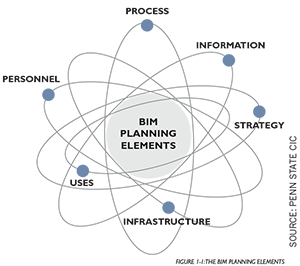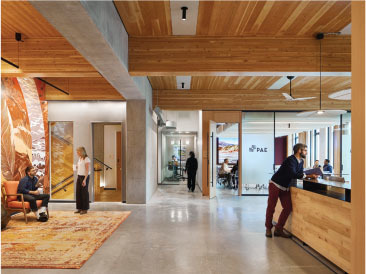January/February 2020
Communities: Private Practice
BIM for Life
BY JACK RAY AND ANGELA R. NEWLAND, P.E., F.NSPE
 In a January/February 2019 PE article, we described building information modeling, the scope of a BIM study by the Transportation Research Board’s Airport Cooperative Research Program, and notable examples of how BIM is being successfully implemented beyond design. This second article elaborates on the contents of the “BIM Beyond Design” Guidebook, slated for publication by ACRP in early 2020. The guidebook recommendations are based on extensive research of aviation and nonaviation entities across the world that are using building information modeling beyond the design phase of their capital projects.
In a January/February 2019 PE article, we described building information modeling, the scope of a BIM study by the Transportation Research Board’s Airport Cooperative Research Program, and notable examples of how BIM is being successfully implemented beyond design. This second article elaborates on the contents of the “BIM Beyond Design” Guidebook, slated for publication by ACRP in early 2020. The guidebook recommendations are based on extensive research of aviation and nonaviation entities across the world that are using building information modeling beyond the design phase of their capital projects.
Guidebook Purpose
This guidebook is focused on helping US airports establish effective life cycle BIM programs. This guidance applies to any type of organization or owner charged with managing significant facilities, as well as the consultants who assist owners in this effort. The guidebook explains how BIM supports a collaborative environment for documenting, analyzing, and sharing facility information across an entire organization. It also elaborates on how BIM can reduce facility/asset development costs, improve asset performance, and enhance facility operational readiness.
Highlights of the key sections in the guidebook are provided below.
Performing a BIM Organizational Assessment
Any BIM implementation should begin with a BIM organizational assessment that includes two parts: a BIM needs assessment and a BIM capabilities assessment. The BIM needs assessment is inclusive of all airport stakeholder groups and engages them in a discussion of the opportunities and challenges related to facility information at their airport. The BIM capabilities assessment will gauge the readiness of an airport to implement BIM. If the results of these efforts conclude that the organization should implement a BIM program, the guidebook provides advice on how the organization should proceed with the development of a BIM roadmap. The BIM roadmap is a phased implementation plan identifying the most mission-critical and least costly facility data needs to be prioritized first, and the least important ones to be addressed in later phases.
Preparing Staff for BIM Implementation
To achieve the greatest benefit from BIM, implementation should be treated as a program of organizational change and transformation. The effort will need to consider BIM’s impact on all organizational functions and business processes, and the contribution that each function and process can make to the success of the organization as a whole. This section of the guidebook outlines how organizations can develop a BIM capabilities maturity model to create a framework for guiding improvements in organizational BIM capabilities over time. It also addresses the top 10 factors contributing to an organization’s capability of effectively implementing BIM:
- Upper management buy-in;
- BIM vision and objectives;
- BIM champion;
- BIM training practices;
- Construction clash detection evaluation;
- BIM education practices;
- Organizational mission statement;
- As-built model geometry evaluation;
- BIM job duties; and
- BIM hiring practices.
Financial Analysis
This section provides an overview of options available to build a business case for BIM and methods for measuring return on investment. Building the business case for BIM may be simplified if it is included as part of building a business case for improving the overall strategic asset life cycle management within the organization.
 Developing a BIM Strategy and Outlining the BIM Process
Developing a BIM Strategy and Outlining the BIM Process
Developing the BIM life cycle process involves establishing BIM within the organization; this is known as BIM implementation planning. The Penn State “Planning Guide for Facility Owners v2.0” provides a good reference for the BIM development process and defines six key planning elements:
- Strategy: goals and objectives
- BIM Uses: applications supported by BIM
- Process: workflow descriptions
- Information: facility data requirements for the BIM
- Infrastructure: technology requirements
- Personnel: roles, responsibilities, and training requirements
The guidebook further elaborates on these planning elements and the development of the BIM life cycle process.
Scaling the Implementation of BIM
This section discusses the scalable aspects of BIM, which need to be evaluated in the BIM roadmap, and how these aspects might fit with the available resources and needs of smaller organizations. While the early adoption of BIM at airports is primarily by large airports and organizations that are managing many large capital projects, small airports/organizations can also benefit from BIM by scaling their programs to meet their operational needs.
Technical Architecture
This section addresses the integration of BIM with existing data management systems. Also, it describes the underlying design requirements for a BIM system that represent the asset data schema and the interfaces necessary to fully support its collaborative benefits.
The technical architecture underlying BIM is primarily focused on the concept of “information exchanges.” An information exchange comprises the standards and methods by which BIM data is shared between stakeholder groups and other facility management systems such as computerized maintenance management systems, enterprise asset management, and property/lease management systems.
In the diagram above, BIM creates the information exchange that enables a collaborative life cycle approach to eliminate the separate data silos and enhances the sharing of vital facility data. This data sharing not only reduces the data loss at handover, but also improves the collection of required data within each life cycle phase. Designers can more fully integrate constructability and maintainability requirements early in the process, where it can have the largest effect on reducing the facility’s overall life cycle cost. Contractors have a greater understanding of the owner’s and designer’s intent, reducing downstream change orders and producing a facility that fully meets the owner’s needs.
The concept of standardized information exchanges is the primary enabler of the collaborative benefits of BIM. The ability to easily exchange information between stakeholder groups throughout the facility or asset life cycle is critical to realizing BIM’s full benefits. Developing a BIM with an open standards-based technical architecture will position the organization to leverage existing BIM tools, processes, and standards, and to benefit from future innovations.
Standards, Execution Plans, and Data Elements
This section addresses how to begin the design of a BIM program. The following elements should be established by an organization that wants to create an effective BIM program:
Standards: Guidelines for the design of the BIM program that will maximize the interoperability of the BIM system with other existing BIM systems. Also, guidelines for the tools and processes that will provide the best path to reusability with future developments and innovations maximizing the longevity of the BIM system.
Execution Plans: Templates for managing the BIM process that define the roles, responsibilities, BIM data and spatial requirements, process diagrams, and overall structure of the BIM program.
Data Elements: Options for the design of the data structure of the facility, systems, and assets within the BIM.
Determining BIM Governance
Once a business case for implementing BIM has been developed, the organization must determine who will manage the BIM program. This includes establishing the policies, procedures, and infrastructure required to effectively deliver BIM across the organization. This section focuses on options for where the accountability for BIM should reside, the roles and responsibilities that need to be established, and the policies and processes required to maintain BIM as a shared facility information resource.
Progress Metrics
Once an organization has established a BIM program, it is important for the airport to measure the effectiveness of the program to guide future corrective actions and improvements. This section identifies metrics that can be established to give an organization the data it needs to ensure that BIM is achieving the established goals. These metrics are often key performance indicators, developed and validated in an organization’s strategic planning process.
Mitigating Legal and Liability Issues
To fully benefit from BIM, a new contractual framework for design and construction contracts needs to be developed that incentivizes open communication and the sharing of facility information. This section discusses the primary legal and liability issues organizations need to consider in the update of their standard design and construction contract language as a part of their BIM program implementation. These issues include:
- Liability
- Ownership of the BIM
- BIM legal status
- Digital data delivery
Summary
BIM for postconstruction facility life cycle management is still in the early phase of adoption around the world. Standards for the processes, technology, and implementation have not yet been well defined. This guidebook presents airport owners, and organizations in general, with options and best practices for implementing BIM with a focus on postconstruction facility management activities. All facility owners and BIM consultants can benefit from the instruction and lessons learned contained within this guidebook.
For More Information
The ACRP “BIM Beyond Design” Guidebook is available for free download or hardcopy purchase at www.trb.org/ACRP.
Jack Ray is vice president and COO of CCI Engineering Services and Angela R. Newland, P.E., F.NSPE, is senior project engineer at CCI.
BIM Information Exchange Diagram



 Volunteering at NSPE is a great opportunity to grow your professional network and connect with other leaders in the field.
Volunteering at NSPE is a great opportunity to grow your professional network and connect with other leaders in the field. The National Society of Professional Engineers (NSPE) encourages you to explore the resources to cast your vote on election day:
The National Society of Professional Engineers (NSPE) encourages you to explore the resources to cast your vote on election day:






